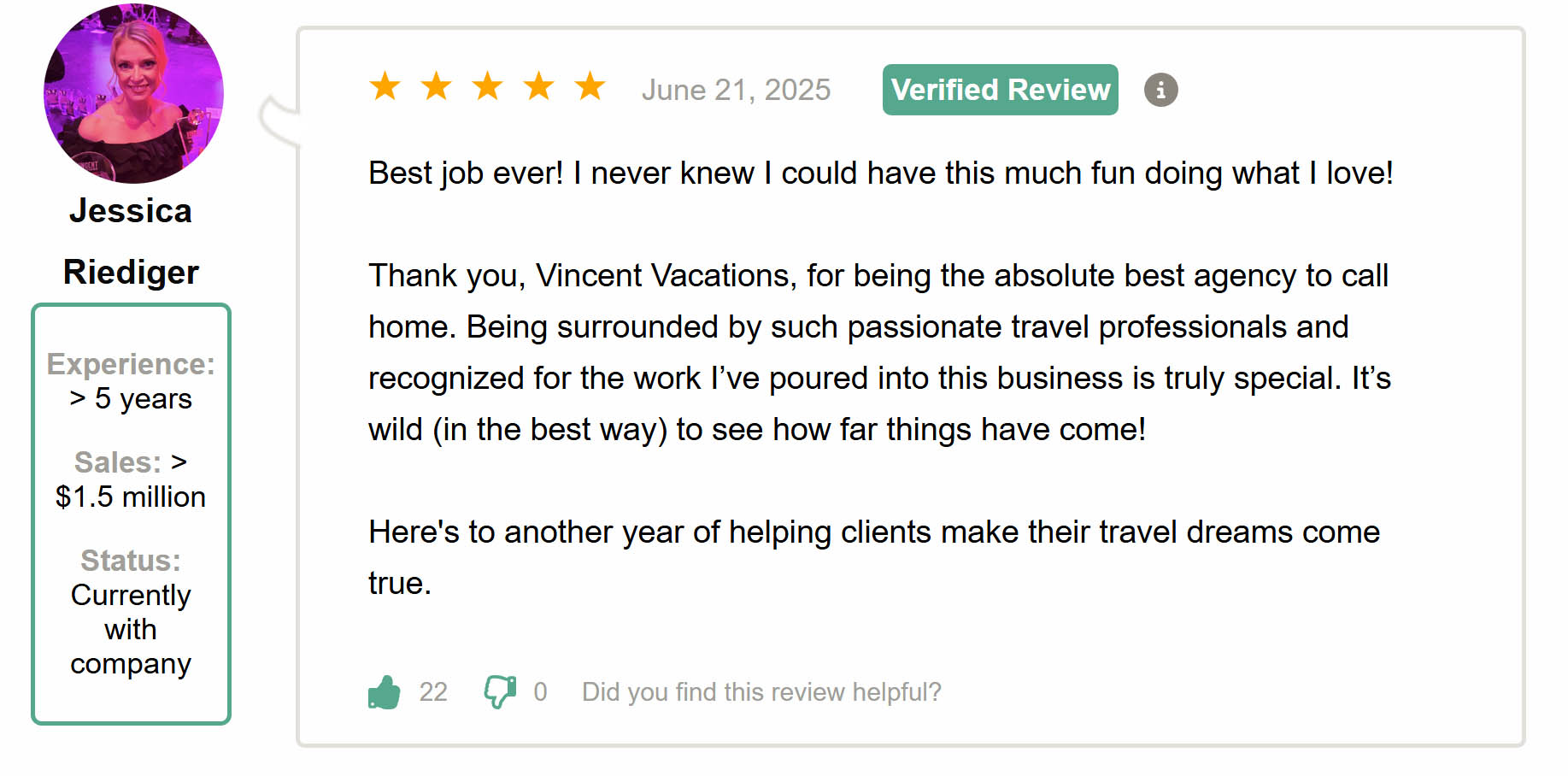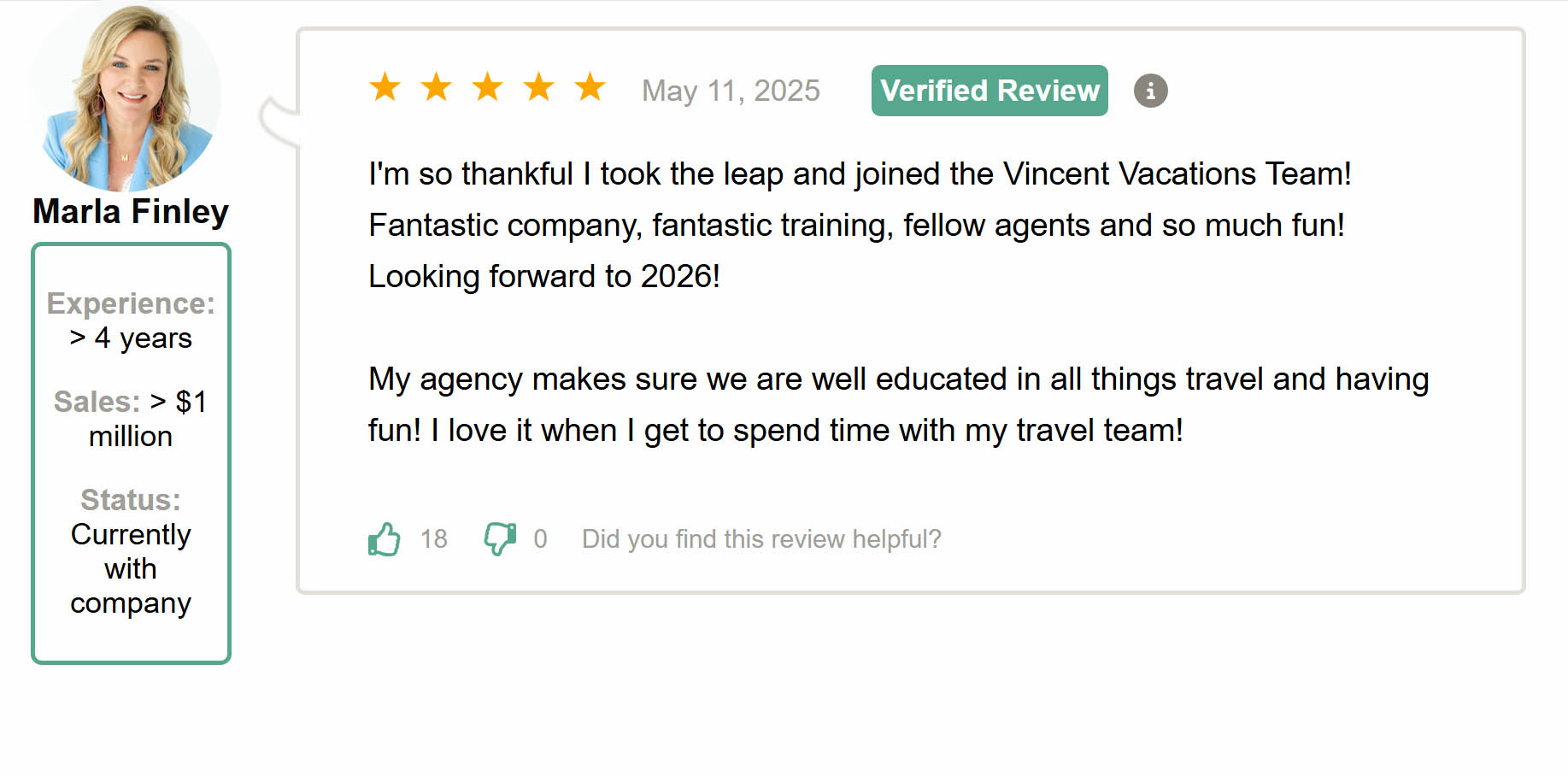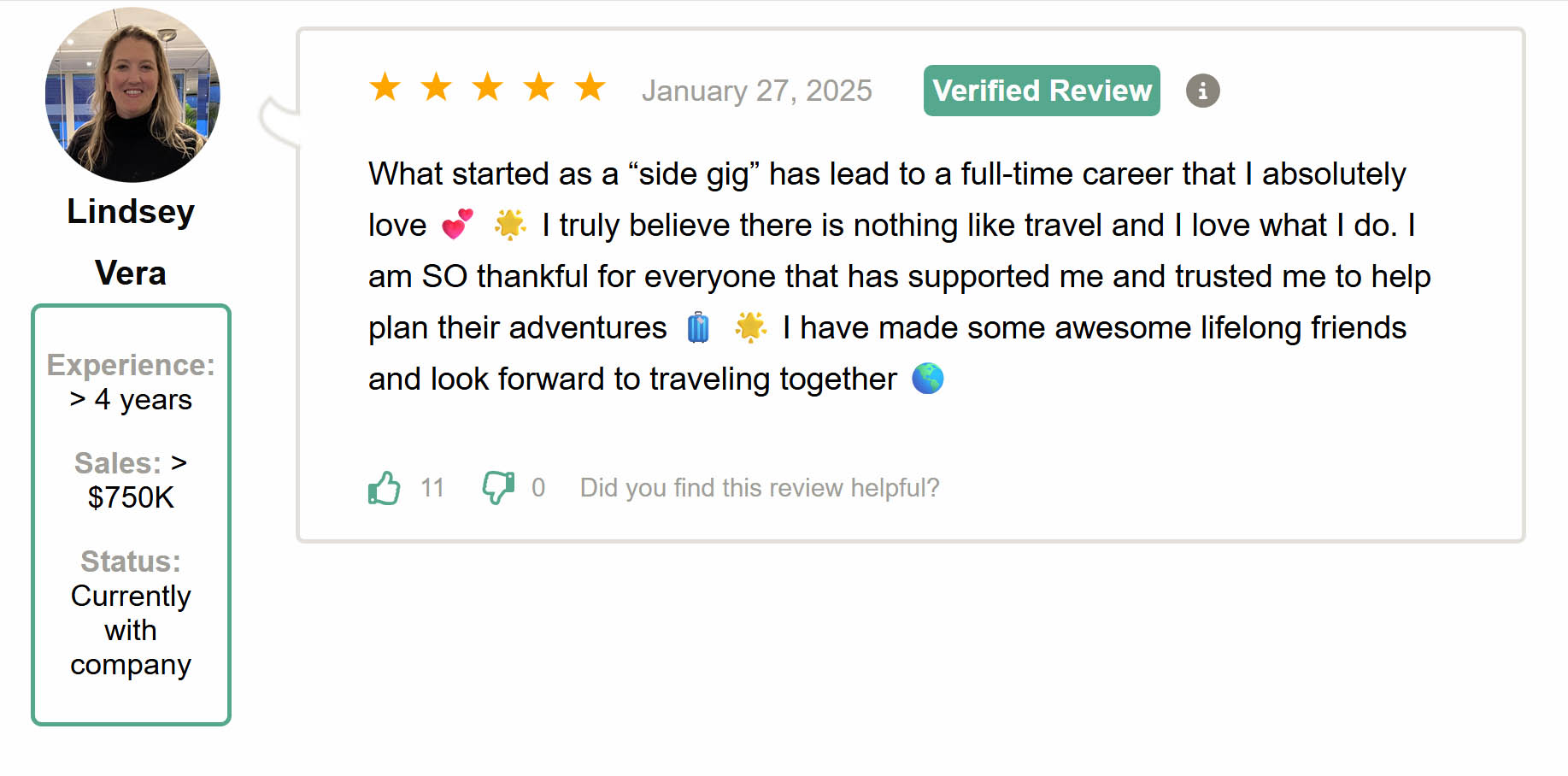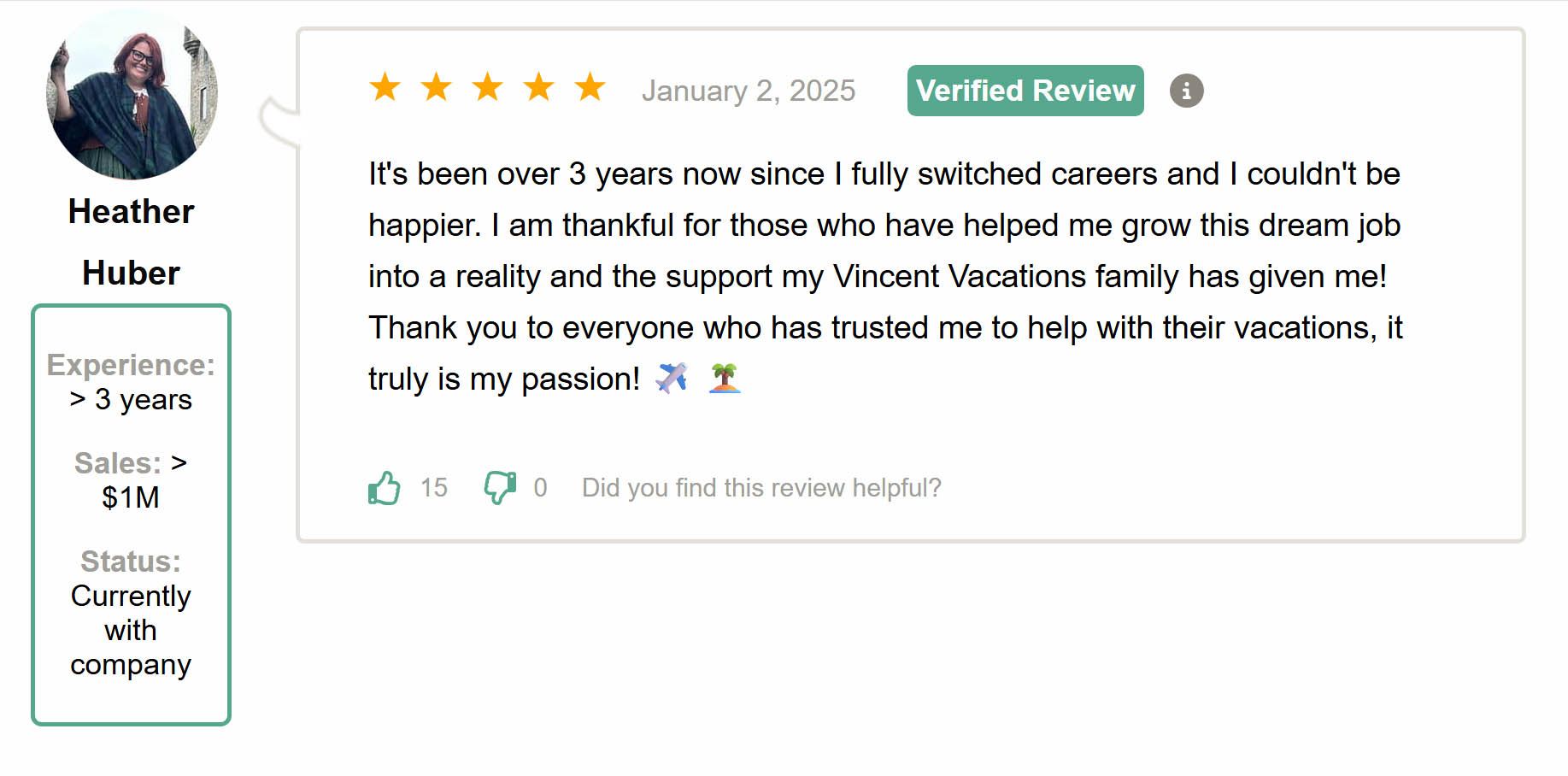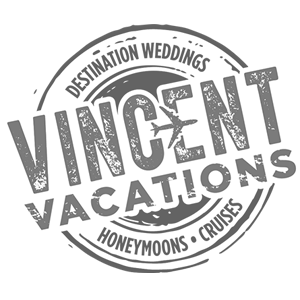Content Marketing Mastery-Creating Viral Travel Content That Converts
To learn more techniques and how to become a travel agent, sign-up to become a travel agent today!
In the ever-competitive travel industry, mastering content marketing is crucial for standing out and driving conversions. Creating viral travel content is not just about attracting eyeballs; it's about crafting a narrative that resonates deeply with your audience, inspiring them to take action and book their next adventure.
To achieve this, it's essential to understand that content marketing is more than just publishing blog posts or social media updates. It's about selling the dream of a perfect vacation, allowing potential travelers to visualize themselves in their ideal destinations. This approach not only drives bookings but also fosters customer loyalty and brand advocacy.

Vincent Vacations
Build your own travel business. Launched by industry veterans, Vincent Vacations is working to carve out a niche as a boutique, community-driven option designed by advisors, for advisors.
Learn MoreAt the heart of any successful content strategy is storytelling. Crafting compelling stories that transport your audience to the destinations you're promoting is key. Share personal anecdotes, experiences, and narratives that create an emotional connection with your readers. This emotional appeal is what inspires readers to imagine themselves in those settings and ultimately take the leap to book their trip.
High-quality images and videos are indispensable in travel content. They capture the beauty and uniqueness of destinations, making them almost tangible for the viewer. Photos of picturesque landscapes, vibrant cityscapes, and cultural experiences can captivate your audience and encourage them to explore further.
Understanding your target audience is paramount. Different types of travelers have different needs and interests. For instance, business travelers care about convenience, efficiency, and ease of access to services like direct flights and quick transportation. In contrast, family travelers are more concerned with safety, comfort, and entertainment options at their destination. Tailoring your content to these specific needs ensures it resonates more deeply and addresses the unique questions and interests of each audience segment.
Optimizing your content for SEO is another critical aspect. Using relevant keywords, especially long-tail keywords and location-specific terms, helps your content appear at the top of search results. This not only improves organic traffic but also positions your brand as an expert for specific destinations. Incorporating structured data, such as FAQ schema and review schema, further enhances your visibility and click-through rates.
By focusing on storytelling, visual appeal, authenticity, and personalization, you can create content that not only goes viral but also converts. This holistic approach ensures that your content marketing efforts are aligned with the user journey, from the awareness stage to the booking stage, providing valuable and relevant information at every step of the way.

Understanding Your Target Audience
To create viral travel content that converts, it is crucial to have a deep understanding of your target audience. This involves several strategies to gather insights and tailor your content accordingly.
Gathering insights through surveys and social media monitoring is a powerful way to understand your audience's preferences and pain points. By conducting surveys, you can ask direct questions about travel habits, preferred destinations, and what influences their booking decisions. Social media monitoring allows you to see what your audience is talking about, what they are interested in, and how they interact with your brand and other travel-related content.
Analyzing website analytics is another key method for understanding your audience. By looking at metrics such as page views, bounce rates, and time spent on page, you can determine which content is most engaging and which areas of your website need improvement. This data helps you refine your content strategy to better meet the needs of your audience.
For instance, if you notice that a particular blog post about "Top 10 Family-Friendly Destinations" has high engagement and low bounce rates, it indicates that this type of content is highly relevant to your audience. You can then create more content around this theme to keep your audience engaged.
Using customer reviews and testimonials is an excellent way to gather feedback and understand what your audience values. Reviews often highlight specific strengths and weaknesses of your services or destinations, providing actionable insights that you can use to improve your offerings. Testimonials, on the other hand, can be used to create compelling content that showcases the positive experiences of your customers.
| Review Aspect | Insight |
|---|---|
| Destination Highlights | Customers often mention specific attractions or experiences they enjoyed. |
| Service Quality | Reviews can indicate whether your customer service is meeting expectations. |
| Value for Money | Feedback on whether the experience was worth the cost can help in pricing strategies. |
Conducting focus groups provides detailed and qualitative insights into your audience's thoughts and behaviors. These sessions allow for in-depth discussions and can uncover nuances that might not be evident through other methods. By engaging directly with your audience, you can gather rich, contextual data that can significantly inform your content strategy.
Benefits of Focus Groups
Focus groups offer a unique opportunity to delve into the motivations, preferences, and pain points of your audience in a personalized and interactive way. This method can reveal subtle aspects of consumer behavior that quantitative data might miss.
For example, a focus group might reveal that families are particularly interested in destinations with kid-friendly activities, which could guide your content creation to include more family-oriented travel guides and tips.
By combining these methods, you can build a comprehensive understanding of your target audience, enabling you to create content that resonates deeply and drives conversions.

Building a Comprehensive Content Strategy
Defining Your Content Objectives and Goals
Defining clear content objectives and goals is the foundation of a successful content strategy. This involves understanding what you want to achieve through your content, whether it's increasing website traffic, boosting engagement, or driving conversions. By setting specific, measurable, achievable, relevant, and time-bound (SMART) goals, you can align your content efforts with your overall business objectives.
Identifying Key Content Channels (Blogs, Social Media, SEO)
Identifying the right content channels is crucial for reaching your target audience effectively. Blogs, social media, and SEO are key channels that can help you achieve your content goals.
Blogs serve as a dynamic and engaging way to provide valuable content to your audience. By creating detailed guides, travel tips, and destination roundups, you can attract and retain a clearly defined audience. Blogs also offer the opportunity to incorporate long-tail keywords, enhancing your SEO efforts and attracting organic traffic.
Social media platforms are ideal for sharing bite-sized content, engaging with your audience, and promoting your blog posts and other content. Platforms like Instagram, Facebook, and Twitter can help you reach a broader audience and drive traffic back to your website.
SEO is essential for making your content visible in search engine results pages (SERPs By optimizing your content with relevant keywords, meta descriptions, and structured data, you can improve your search rankings and attract more targeted traffic to your website.
| Content Channel | Use |
|---|---|
| Blogs | Providing in-depth travel guides, tips, and destination roundups. |
| Social Media | Sharing bite-sized content, engaging with the audience, and promoting blog posts. |
| SEO | Optimizing content for search engines to improve visibility and drive organic traffic. |
Vincent Vacations
Build your own travel business. Launched by industry veterans, Vincent Vacations is working to carve out a niche as a boutique, community-driven option designed by advisors, for advisors.
Learn MoreCreating a Content Calendar for Consistency
A content calendar is a vital tool for maintaining consistency in your content publication schedule. It helps you plan, organize, and schedule your content in advance, ensuring that you regularly publish high-quality content that engages your audience.
Benefits of a Content Calendar
A content calendar allows you to plan thematic content around seasonal events, holidays, or special promotions. It also helps in avoiding last-minute scrambles and ensures that all your content pieces align with your overall strategy.
For example, you might plan content around summer vacation tips in the spring or holiday travel guides in the fall. This strategic planning keeps your content fresh and relevant to the current needs of your audience.
Budgeting for Content Creation and Promotion
Budgeting is a critical aspect of any content strategy. You need to allocate resources for content creation, including writing, design, photography, and video production. Additionally, budgeting for content promotion, such as social media advertising and SEO tools, is essential for reaching a wider audience.
Allocating a budget for content promotion is also crucial. This includes expenses for social media ads, email marketing tools, and SEO software. By investing in these areas, you can amplify the reach of your content and drive more traffic and conversions.
// Sample Budget Breakdown
// Content Creation: 60%
// Content Promotion: 30%
// SEO Tools: 10%
By defining clear objectives, identifying key content channels, creating a content calendar, and budgeting effectively, you can build a comprehensive content strategy that drives engagement, traffic, and ultimately, conversions.
Become a Travel Agent: Unleash Your Full Potential
Ready for a career that's as fulfilling as it is rewarding? Becoming a travel agent with Vincent Vacations means building a business around your passion for travel.

Crafting Engaging Content for Travelers
Writing Aspirational Travel Guides and Destination Roundups
Aspirational travel guides and destination roundups are cornerstone pieces of content that can inspire and motivate travelers to plan their next adventure. These guides should be rich in detail, highlighting the unique attractions, cultural experiences, and natural beauty of each destination. Use vivid descriptions and compelling storytelling to transport your readers to these exotic locations.
For instance, a travel guide for a tropical island might include descriptions of pristine beaches, lush forests, and vibrant local markets. Share personal anecdotes or experiences from travelers who have visited these destinations to add an authentic touch.
To make these guides even more engaging, incorporate high-quality visuals such as photos and videos that showcase the destination's essence. This visual appeal will help readers visualize themselves in these settings and foster a deeper connection with the content.
Creating Destination FAQs and Seasonal Travel Guides
Destination FAQs and seasonal travel guides are invaluable resources for travelers, providing them with the information they need to plan and prepare for their trips. FAQs should address common questions about destinations, such as the best time to visit, must-see attractions, and practical tips for navigating the area.
| Question | Answer |
|---|---|
| What is the best time to visit Paris? | Spring and autumn are the best times to visit Paris, offering mild weather and fewer tourists. |
| What are the must-see attractions in Tokyo? | Tokyo Tower, Shibuya Crossing, and the Meiji Shrine are some of the top attractions. |
Seasonal travel guides should be tailored to the specific time of year, highlighting events, festivals, and activities that are unique to each season. For example, a winter travel guide might focus on ski resorts and holiday markets, while a summer guide could highlight beach destinations and outdoor festivals.
Benefits of Seasonal Guides
Seasonal guides help travelers plan according to the time of year, ensuring they make the most of their trip. These guides also keep your content fresh and relevant, as they are updated periodically to reflect current events and trends.
Developing Comparison Guides and Reviews of Travel Services
Comparison guides and reviews of travel services are essential for helping travelers make informed decisions about their trips. These guides should compare different travel services, such as airlines, hotels, and tour operators, based on factors like price, quality, and customer service.
A comparison guide for budget airlines, for example, might evaluate the amenities, flight schedules, and customer reviews of different airlines to help travelers choose the best option for their needs.
Reviews should be detailed and honest, providing readers with a clear understanding of what to expect from each service. Use ratings and testimonials from other travelers to add credibility and trustworthiness to your reviews.
Producing Fun Travel Tip Videos and Infographics
Fun travel tip videos and infographics are excellent ways to engage travelers with bite-sized, easily digestible content. These formats are perfect for sharing practical tips and hacks that can make a traveler's journey smoother and more enjoyable.
// Example Video Script
// Segment 1: Introduction
// Segment 2: Packing Tips
// Segment 3: Airport Hacks
// Segment 4: Cultural Etiquette
Videos can range from quick tips on how to pack efficiently to more in-depth guides on navigating airport security or dealing with cultural differences. Infographics can visually represent these tips, making them easy to share and refer to later.
Pack light, use a carry-on, and roll your clothes to save space.
By incorporating trending audio, engaging visuals, and interactive elements, you can make these videos and infographics highly shareable and engaging for your audience.
Tips for Creating Shareable Content
Use trending indicators to discover popular audio and formats that can expand your presence. Engage with your audience by responding to comments and creating a community around your content. Utilize tools like CapCut for editing to elevate the quality of your videos.

Optimizing Content for SEO in the Travel Industry
Optimizing SEO Titles and Meta Descriptions
Optimizing your SEO titles and meta descriptions is crucial for improving the visibility of your travel content in search engine results. SEO titles should be concise, yet descriptive, and include the primary keyword you are targeting. For example, if you are writing about a travel guide to Paris, your title could be "Ultimate Travel Guide to Paris: Top Attractions and Tips."
Meta descriptions provide a brief summary of your content and should entice users to click through. ensure they are under 160 characters and include your target keyword. a well-crafted meta description can significantly improve your click-through rate.
Using Long-Tail Keywords Related to Key Destinations
Long-tail keywords are more specific phrases that have lower search volumes but are also less competitive. In the travel industry, using long-tail keywords related to key destinations can help you target specific search queries and attract highly relevant traffic.
| Destination | Long-Tail Keyword |
|---|---|
| Paris | "best family-friendly attractions in Paris" |
| Tokyo | "top budget-friendly restaurants in Tokyo" |
Vincent Vacations
Build your own travel business. Launched by industry veterans, Vincent Vacations is working to carve out a niche as a boutique, community-driven option designed by advisors, for advisors.
Learn MoreBy incorporating these long-tail keywords naturally into your content, you can improve your search engine rankings and attract users who are looking for specific information about their desired destinations.
Optimizing URL Slugs and Image Alt Text
URL slugs and image alt text are often overlooked but are essential for SEO optimization. URL slugs should be clean, descriptive, and include your target keyword. For example, a URL slug for a blog post about "Top 10 Beaches in Bali" could be "/top-10-beaches-in-bali>.
// Example URL Slug
// https://example.com/top-10-beaches-in-bali
Image alt text is crucial for search engines to understand the content of your images. Include descriptive alt text that includes your target keyword. For instance, an image of the Eiffel Tower could have the alt text "Eiffel Tower in Paris, France."
Including Keywords in Headings and Subheadings
Including keywords in your headings and subheadings can further optimize your content for SEO. Headings (H1, H2, H3, etc.) help structure your content and make it more readable, while also providing additional signals to search engines about the relevance of your content.
Benefits of Keyword-Rich Headings
Using keywords in headings ensures that your content is well-organized and easy to navigate. It also helps search engines understand the hierarchy and relevance of your content, which can improve your search rankings.
For example, if you are writing a travel guide to New York City, your headings could include "Best Time to Visit New York City," "Top Attractions in New York City," and "Budget-Friendly Restaurants in New York City."
By strategically placing your target keywords in these headings, you can enhance the SEO of your content and make it more discoverable by users searching for travel-related information.

Content Marketing Across the User Journey
Awareness Stage: Capturing Attention with Aspirational Content
In the awareness stage, the goal is to capture the attention of potential travelers and inspire them to consider your destination or travel service. Aspirational content is key here, as it helps to create a desire for travel and exploration. Use high-quality visuals, compelling narratives, and emotional storytelling to transport your audience to the destinations you are promoting.
For example, a video showcasing the breathtaking landscapes of a tropical island, complete with crystal-clear waters and lush green forests, can evoke a strong sense of wanderlust. Share personal anecdotes or experiences that highlight the unique attractions and cultural experiences of the destination.
Research Stage: Providing Destination FAQs and Budget Planning Tools
During the research stage, travelers are looking for detailed information to help them plan their trip. Providing destination FAQs and budget planning tools can be incredibly valuable, as they address common questions and concerns that travelers have.
| Question | Answer |
|---|---|
| What are the must-see attractions in Paris? | The Eiffel Tower, Louvre Museum, and Notre-Dame Cathedral are some of the top attractions. |
| How do I plan a budget-friendly trip to Tokyo? | Consider staying in hostels, eating at local restaurants, and using public transportation. |
Budget planning tools, such as cost calculators or travel budget guides, can also help travelers plan their finances effectively. These tools make your content more practical and useful, increasing the likelihood that travelers will return to your site for more information.
Benefits of Budget Planning Tools
Budget planning tools not only provide valuable information but also position your brand as a trusted resource. By offering these tools, you can build trust with your audience and keep them engaged throughout their planning process.
Decision-Making Stage: Offering Comparison Guides and Reviews
In the decision-making stage, travelers are comparing different options and making final decisions about their trip. Offering comparison guides and reviews can help them make informed choices.
For instance, a comparison guide for different airlines or hotels can include factors such as price, amenities, and customer reviews. This helps travelers weigh their options and choose the best fit for their needs.
Reviews from other travelers can also be incredibly influential. Include testimonials, ratings, and detailed reviews to provide a comprehensive view of each service or destination.
Booking and Preparation Stage: Step-by-Step Booking Guides and Travel Checklists
As travelers move into the booking and preparation stage, they need step-by-step guides and travel checklists to help them finalize their plans. Step-by-step booking guides can walk travelers through the process of booking flights, hotels, and other travel services.
// Example Step-by-Step Guide
// Step 1: Search for Flights
// Step 2: Book Your Flight
// Step 3: Choose Your Accommodation
// Step 4: Plan Your Itinerary
Travel checklists can include essential items to pack, documents to prepare, and other pre-travel tasks. These tools ensure that travelers are well-prepared for their trip and can reduce anxiety associated with travel planning.
Packing List, Travel Documents, and Itinerary are crucial elements to include.
Travel Stage: Interactive Itineraries and Local Experience Guides
During the travel stage, travelers are looking for interactive itineraries and local experience guides to enhance their trip. Interactive itineraries can be customized to include specific activities, attractions, and experiences that travelers want to have.
Benefits of Interactive Itineraries
Interactive itineraries keep travelers engaged and informed throughout their trip. They can include real-time updates, maps, and recommendations based on the traveler's preferences and current location.
Local experience guides should highlight unique experiences and hidden gems that only locals know about. This could include recommendations for local restaurants, off-the-beaten-path attractions, and cultural events.
For example, a local experience guide for New York City might include tips on where to find the best pizza, how to navigate the subway system, and which lesser-known museums are worth visiting.
For Both Aspiring and Experienced Travel Advisors
Build a travel business doing what you love - on your own terms. Start booking trips the day you join, with a best-in-class education curriculum developed by industry experts.

Leveraging Diverse Content Formats
Using Videos for Destination Showcases and Travel Tips
Videos are an excellent way to showcase destinations and provide valuable travel tips, making them a powerful tool in your content marketing arsenal. By incorporating high-quality video production, you can capture the essence of a destination and transport your viewers into the heart of the travel experience.
The essence of viral travel videos lies in their ability to tell a compelling story. Start with a clear, engaging introduction that sets the scene and invites viewers into the experience. Use the narrative to guide them through the journey, highlighting moments of discovery, joy, and awe.
Creating Infographics for Travel Itineraries and Packing Lists
Infographics are visually appealing and easy to digest, making them perfect for travel itineraries and packing lists. These visual aids can help travelers plan their trips more efficiently and ensure they don’t forget essential items.
| Day | Activity | Location |
|---|---|---|
| Day 1 | Arrival and Check-In | Hotel in City Center |
| Day 2 | City Tour | Local Landmarks |
Vincent Vacations
Build your own travel business. Launched by industry veterans, Vincent Vacations is working to carve out a niche as a boutique, community-driven option designed by advisors, for advisors.
Learn MorePacking lists can be similarly formatted, including sections for clothing, documents, and miscellaneous items. This structured approach makes it easy for travelers to prepare for their trip.
Clothing, Documents, and Miscellaneous are key sections to include.
Implementing Interactive Maps for Personalized Recommendations
Interactive maps can provide personalized recommendations to travelers, enhancing their travel experience. These maps can include markers for top attractions, local restaurants, and hidden gems, allowing travelers to customize their itinerary based on their interests.
Benefits of Interactive Maps
Interactive maps offer real-time updates and can be accessed on various devices, making them highly convenient for travelers. They also allow for user interaction, such as adding personal notes or favorite spots, which can be shared with others.
By integrating these maps into your content, you can provide a more immersive and interactive experience for your audience, helping them plan their trips more effectively.
Developing Tools like Travel Budget Calculators and Packing Checklists
Tools such as travel budget calculators and packing checklists are invaluable resources for travelers. A travel budget calculator can help travelers estimate costs for their trip, including flights, accommodations, and activities.
// Example Budget Calculator
// Input: Destination, Number of Travelers, Duration of Stay
// Output: Estimated Total Cost
Packing checklists can be developed as downloadable resources or interactive tools that travelers can use to ensure they pack everything they need. These tools add practical value to your content and can be shared widely among travelers.
Offering Ebooks as Gated Content for Comprehensive Travel Guides
Ebooks can serve as comprehensive travel guides, offering in-depth information that travelers can access by providing their contact information. This gated content strategy helps you capture leads while providing valuable resources to your audience.
Ebooks can include detailed travel itineraries, cultural insights, and practical tips that make them indispensable for travelers. By offering this content in exchange for contact information, you can build your email list and maintain a connection with potential travelers.
Sending Newsletters with Exclusive Deals and Curated Travel Tips
Newsletters are an effective way to keep your audience engaged and informed about exclusive deals, curated travel tips, and upcoming travel opportunities. By personalizing your newsletters, you can build a closer connection with your readers and keep them interested in your brand.
Benefits of Newsletters
Newsletters allow you to share exclusive content that isn’t available on your website or social media channels. This can include special promotions, early access to new travel guides, or insider tips that make your readers feel valued.
Interactive elements within newsletters, such as polls or questions, can also encourage engagement and feedback from your audience.
By incorporating diverse content formats such as videos, infographics, interactive maps, tools, ebooks, and newsletters, you can create a rich and engaging content strategy that caters to the varied needs and preferences of your audience.

Measuring Success and Optimizing Content
Tracking Engagement Metrics and Conversion Rates
To measure the success of your viral travel content, it's crucial to track engagement metrics and conversion rates. Engagement metrics include likes, shares, comments, and time spent on the content. These indicators help you understand how well your content is resonating with your audience.
| Metric | Description |
|---|---|
| Likes and Shares | Indicators of how well the content is liked and shared by the audience. |
| Comments | Measure of audience engagement and interaction with the content. |
| Conversion Rate | Percentage of users who complete a desired action, such as booking a trip. |
Analyzing Website Analytics for Content Performance
Website analytics provide a wealth of information about how your content is performing. By analyzing metrics such as page views, bounce rates, and average session duration, you can identify which content is most engaging and which areas need improvement.
Tools like Google Analytics can help you track these metrics and identify trends. For instance, if a particular blog post has high page views and low bounce rates, it indicates that the content is highly relevant and engaging for your audience.
// Example Google Analytics Metrics
// Page Views: 1000
// Bounce Rate: 20%
// Average Session Duration: 3 minutes
Using Feedback to Refine Content Strategy
Feedback from your audience is invaluable for refining your content strategy. By collecting and analyzing comments, messages, and reviews, you can understand what your audience likes and dislikes about your content.
Benefits of Feedback
Feedback helps you identify gaps in your content and areas where you can improve. It also provides insights into what types of content are most appreciated by your audience, allowing you to tailor your strategy accordingly.
For example, if many of your viewers comment on how helpful your travel tips are, you can create more content around this theme to keep your audience engaged.
Responding to feedback and engaging with your audience builds trust and loyalty, making them more likely to share your content and return for more.
Adjusting SEO Strategies Based on Search Engine Rankings
Adjusting your SEO strategies based on search engine rankings is essential for maintaining and improving your content's visibility. By analyzing your search engine rankings, you can identify which keywords and content types are performing well and which need optimization.
Use tools like Google Search Console to monitor your search rankings and adjust your SEO strategies accordingly. For instance, if you notice that a particular blog post is ranking high for a specific keyword, you can create more content around that keyword to leverage the existing traffic.
| Keyword | Current Ranking | Optimization Action |
|---|---|---|
| "Best Beaches in Bali" | 5th | Optimize meta description and headings to include the keyword. |
| "Top Attractions in Paris" | 10th | Create more content around this keyword and build backlinks. |
By continuously monitoring and adjusting your SEO strategies, you can ensure that your content remains visible and attractive to your target audience.

Conclusion: Mastering the Art of Viral Travel Content
Creating viral travel content that converts is a multifaceted endeavor that requires a deep understanding of your audience, a well-crafted content strategy, and a keen eye for optimization. By embracing the power of storytelling, leveraging high-quality content formats, and optimizing for SEO, you can significantly enhance the reach and impact of your travel content.
The journey to creating viral travel content involves more than just publishing engaging posts; it's about building a connection with your audience and providing them with valuable, relevant information at every stage of their travel planning process.
By diversifying your content formats—using videos, infographics, interactive maps, and tools like travel budget calculators—and distributing them across multiple platforms, you can ensure that your content reaches a broad and engaged audience. Collaborations with influencers, brands, and other content creators further amplify your reach and credibility.
| Strategy | Description |
|---|---|
| Storytelling | Use compelling narratives to capture attention and evoke emotional connections. |
| Content Diversification | Leverage videos, infographics, interactive maps, and tools to engage your audience. |
| SEO Optimization | Use relevant keywords, structured data, and optimize for search engine rankings. |
| Cross-Platform Distribution | Share content on multiple platforms to maximize reach and engagement. |
Final Tips for Success
Remember to continuously measure and optimize your content's performance. Analyze engagement metrics, website analytics, and feedback to refine your strategy. This iterative approach ensures that your content remains relevant and effective in driving conversions.
Lastly, authenticity and consistency are key. Share personal experiences, demonstrate real-time reactions, and stay true to your brand's voice. This authenticity builds trust and loyalty with your audience, making your content more shareable and impactful.
As you embark on this journey to master content marketing for travel, keep in mind that success is not a one-time achievement but a continuous process of creation, optimization, and engagement. By staying adaptable, innovative, and focused on your audience's needs, you can create viral travel content that not only inspires but also converts.
Travel is about experiences, connections, and memories. Your content should reflect this, inspiring others to embark on their own adventures and choose your brand as their trusted guide.
Keep exploring, keep engaging, and most importantly, keep surprising. 🌍✈️
Learn more about this by signing up for one of our online trainings Learn More
To learn more techniques and how to become a travel agent, sign-up to become a travel agent today!


